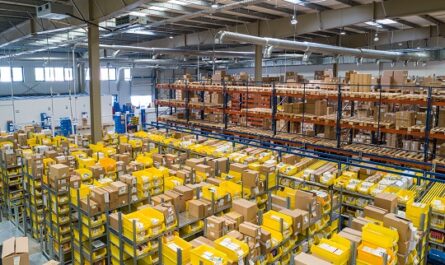In today’s fast-paced global economy, the supply chain has evolved significantly, propelled by advancements in technology and changing consumer demands. However, along with these advancements come a new set of challenges that require innovative solutions.
Before we go further into this topic, don’t forget to follow my LinkedIn account. You’ll get more helpful insights on supply chain management there.
Table of Contents
Technological Advancements
The integration of technologies like artificial intelligence (AI), blockchain, and the Internet of Things (IoT) has dramatically transformed supply chain management. AI helps predict demand, optimize routes, and manage inventory more efficiently by analyzing vast amounts of data. This leads to better decision-making and reduced costs.
Blockchain technology provides a secure and transparent way to track products from their origin to the final customer. Each transaction is recorded in a tamper-proof ledger, ensuring the authenticity and traceability of goods. This reduces fraud and increases trust among all parties involved in the supply chain.
IoT involves using sensors and devices to collect real-time data on the condition and location of goods. This real-time monitoring improves visibility across the supply chain, allowing companies to quickly address issues like delays or damage. Together, these technologies enhance overall efficiency, reduce waste, and improve customer satisfaction.
Globalization
Supply chains have become more global, with companies sourcing materials and components from different parts of the world. This globalization allows businesses to find cost-effective suppliers and expand their market reach, benefiting from lower production costs and access to new customers.
However, this global approach also brings challenges. Geopolitical risks, such as trade disputes and political instability, can disrupt the flow of goods and materials. Companies must navigate various trade regulations, which can differ greatly between countries, adding complexity to their operations and increasing the risk of delays or legal issues.
Additionally, cultural differences can impact communication and business practices. Misunderstandings or conflicts can arise when dealing with suppliers and partners from diverse cultural backgrounds. To manage these complexities, companies need to develop strategies for mitigating risks, understanding regulations, and fostering effective cross-cultural communication.
Customer Expectations
Today’s consumers expect fast delivery, personalized products, and seamless shopping experiences. They want their purchases to arrive quickly and prefer products tailored to their specific needs and preferences. This high expectation has put pressure on supply chains to be more efficient and customer-focused.

To meet these demands, supply chains have become more agile and responsive. Just-in-time manufacturing is one approach that has gained popularity. It involves producing goods only when they are needed, reducing inventory costs and ensuring that products are fresh and up-to-date. This method allows companies to respond quickly to changes in consumer demand without overproducing.
Omnichannel distribution is another concept that has emerged to address consumer expectations. It involves using multiple channels, such as online stores, physical shops, and mobile apps, to provide a seamless shopping experience. By integrating these channels, companies can ensure that customers can shop in the way that is most convenient for them and receive their products quickly and efficiently. This approach enhances customer satisfaction and loyalty.
Sustainability
Environmental and social responsibility have become crucial in supply chain management. Companies are increasingly aware of their impact on the planet and society, and there is growing pressure to act sustainably. This means they need to reduce their carbon footprint by cutting down on greenhouse gas emissions from transportation and production processes.
Minimizing waste is another key focus. Companies are looking for ways to use resources more efficiently, recycle materials, and reduce packaging. By doing so, they not only help the environment but also lower costs and improve their public image. Waste reduction initiatives are becoming standard practice in modern supply chain management.
Ensuring ethical sourcing practices is equally important. Companies must verify that their suppliers adhere to fair labor practices and do not exploit workers or use child labor. They also need to ensure that raw materials are sourced responsibly, without harming communities or ecosystems. By prioritizing ethical sourcing, companies build trust with consumers and create a positive impact on society.
You might also like:
- Dealing with Numerous Audit Findings without Budget for Improvement
- Is PPIC the Enemy of All Departments? Myth or Fact?
Resilience
Recent disruptions, like the COVID-19 pandemic, have shown how crucial it is for supply chains to be resilient. The pandemic caused major delays and shortages, making it clear that companies need to be better prepared for unexpected events. This has led businesses to rethink how they manage their supply chains to handle such disruptions more effectively.
To mitigate risks, companies are now focusing on diversifying their supply sources. Instead of relying on a single supplier or region, they are building relationships with multiple suppliers across different locations. This way, if one supplier is affected by a natural disaster or political issue, they can still get the materials they need from another source.
Additionally, companies are investing in better technology and data analytics to improve their supply chain visibility. By having real-time information on their supply chain operations, they can quickly identify and respond to potential problems. This proactive approach helps ensure that they can continue to meet customer demands, even in the face of unexpected challenges.
However, with these advancements come new challenges. Let’s take a look.
Cybersecurity Risks
As supply chains become more digitized, they face a higher risk of cyberattacks and data breaches. With more information stored and shared online, hackers have more opportunities to access sensitive data. This makes protecting this information a top priority for supply chain professionals.
Ensuring the integrity of digital transactions is crucial. If data is tampered with or stolen, it can lead to significant disruptions and financial losses. Companies need to implement strong cybersecurity measures, such as encryption and regular security audits, to safeguard their systems and data from potential threats.
Additionally, training employees on cybersecurity best practices is essential. Workers need to be aware of the risks and know how to recognize and respond to potential threats. By combining advanced technology with knowledgeable staff, companies can better protect their supply chains from cyberattacks and ensure the security of their operations.
Data Management
The large amount of data produced by interconnected supply chain systems can be overwhelming for companies. Every step in the supply chain generates data, from production and transportation to sales and customer feedback. Managing and making sense of all this information can be challenging.

To handle this, companies need to invest in strong data analytics capabilities. Advanced analytics tools can process vast amounts of data quickly and accurately. These tools help companies identify patterns, trends, and potential issues that might not be obvious at first glance. By using data analytics, businesses can turn raw data into useful insights.
These insights are crucial for making informed decisions. For example, data analytics can help predict demand, optimize inventory levels, and improve delivery times. By basing decisions on accurate data, companies can operate more efficiently, reduce costs, and better meet customer needs. Investing in data analytics is essential for navigating the complexities of modern supply chains.
Skills Gap
With technology evolving rapidly, supply chain professionals need to keep up with a diverse set of skills. These include the ability to analyze data effectively, understand digital tools and platforms, and solve complex problems that arise in the supply chain. The traditional skills of supply chain management are still valuable, but new technologies require professionals to adapt and learn new capabilities.
Bridging the skills gap is crucial for supply chain professionals to fully utilize emerging technologies. This involves investing in training and development programs to ensure that employees have the necessary skills and knowledge. Companies can offer workshops, online courses, and hands-on training to help their staff become proficient in areas such as data analysis, digital literacy, and problem-solving.
By equipping supply chain professionals with the right skills, companies can harness the full potential of emerging technologies. With a workforce that is knowledgeable and adaptable, businesses can implement new tools and processes more effectively, leading to increased efficiency and competitiveness in the market. Bridging the skills gap is essential for supply chain professionals to thrive in an increasingly digital and fast-paced environment.
You might also like:
- How Often Should Operations Audits Be Conducted?
- How to Find Affordable Suppliers: A Comprehensive Guide
To prepare for these challenges, organizations can adopt the following strategies:
Invest in Technology
Embracing emerging technologies can greatly improve the effectiveness of supply chain management. These technologies offer enhanced visibility, allowing companies to track their products and materials at every stage of the supply chain. With better visibility, businesses can identify inefficiencies and bottlenecks, leading to smoother operations and improved customer satisfaction.

Implementing supply chain management software is one way to leverage technology for better efficiency. This software helps companies streamline their processes, automate repetitive tasks, and manage inventory more effectively. By centralizing data and operations in one platform, businesses can reduce errors, minimize delays, and make quicker decisions.
IoT sensors are another valuable technology for enhancing supply chain management. These sensors can be attached to products, equipment, or vehicles to collect real-time data on their location, condition, and performance. By using IoT sensors, companies can monitor the movement of goods, track temperature-sensitive items, and predict maintenance needs. This information enables proactive decision-making and ensures that products reach their destination safely and on time.
Collaborate with Partners
Fostering collaboration and transparency among supply chain partners is essential for creating a resilient and responsive supply chain ecosystem. By working closely together, companies can better understand each other’s needs, capabilities, and challenges. This collaboration allows partners to share information, coordinate efforts, and address potential risks more effectively.
Building strong relationships with suppliers, manufacturers, and logistics providers is key to fostering collaboration in the supply chain. When partners trust and communicate openly with each other, they can work together to identify and mitigate risks. This might include sharing data on inventory levels, production schedules, or market trends. By collaborating closely, companies can respond more quickly to changes in demand or disruptions in the supply chain.
Transparency is also crucial for building trust and collaboration among supply chain partners. When companies are transparent about their operations, policies, and performance, it creates a sense of accountability and reliability. This transparency allows partners to make informed decisions and build stronger relationships based on mutual respect and shared goals. Ultimately, fostering collaboration and transparency among supply chain partners is essential for creating a resilient and agile supply chain ecosystem.
Prioritize Sustainability
Integrating sustainability into supply chain decision-making processes is vital for businesses to reduce their environmental impact and contribute to a more sustainable future. This involves considering the environmental and social consequences of every step in the supply chain, from sourcing raw materials to delivering the final product to customers. By prioritizing sustainability, companies can minimize their carbon footprint and conserve natural resources.
One way to integrate sustainability into the supply chain is by sourcing materials from eco-friendly suppliers. This means selecting suppliers that prioritize sustainability in their operations, such as using renewable energy, minimizing waste, and employing fair labor practices. By partnering with eco-friendly suppliers, companies can ensure that their products are produced in an environmentally responsible manner, reducing the overall environmental impact of their supply chain.
Optimizing transportation routes is another important aspect of sustainable supply chain management. By carefully planning and coordinating transportation activities, companies can minimize fuel consumption, reduce emissions, and lower transportation costs. This might involve consolidating shipments, using more fuel-efficient vehicles, or choosing alternative modes of transportation, such as rail or sea freight. By optimizing transportation routes, companies can achieve significant environmental and cost savings while also improving the efficiency of their supply chain operations.
Develop Talent
Investing in training and development programs is essential for ensuring that employees have the skills and knowledge needed to succeed in the rapidly changing supply chain landscape. By providing training opportunities, companies can help employees stay up-to-date with the latest trends, technologies, and best practices in supply chain management. This enables them to adapt to new challenges and seize opportunities for improvement.
Encouraging cross-functional collaboration is another effective way to foster innovation and adaptability in the supply chain. By bringing together employees from different departments and areas of expertise, companies can leverage diverse perspectives and insights to solve complex problems and identify new opportunities. Cross-functional collaboration encourages creativity and innovation, leading to more effective solutions and better outcomes for the business.
Continuous learning is also crucial for staying competitive in the evolving supply chain landscape. By promoting a culture of continuous learning, companies can empower employees to take ownership of their professional development and stay ahead of the curve. This might involve offering access to online courses, workshops, and other learning resources, as well as providing opportunities for on-the-job training and mentorship. By investing in training, encouraging collaboration, and fostering a culture of continuous learning, companies can equip their employees with the skills and knowledge needed to thrive in the dynamic and ever-changing world of supply chain management.
Conclusion
The evolution of supply chain management, driven by technological advancements and changing global dynamics, has brought about unprecedented improvements in efficiency, visibility, and responsiveness. However, these advancements also introduce new challenges, such as cybersecurity risks, data management complexities, and a growing skills gap.
To navigate these challenges, organizations must invest in cutting-edge technologies, foster strong collaborations with supply chain partners, prioritize sustainability, and focus on continuous talent development. By adopting these strategies, companies can build resilient and adaptive supply chains capable of thriving in the ever-evolving global landscape.
I hope you find it helpful!
Please share this article with your colleagues so they can also benefit. For more insights on supply chain management, follow my LinkedIn account. You’re free to use all articles on this blog for any purpose, even for commercial use, without needing to give credit.
 by
by 
